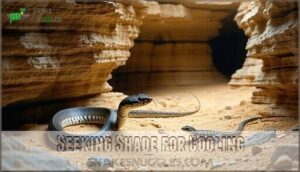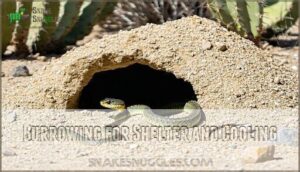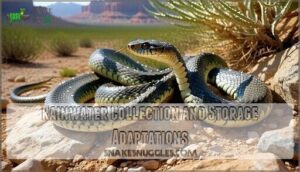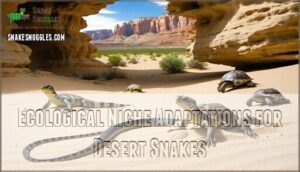This site is supported by our readers. We may earn a commission, at no cost to you, if you purchase through links.

You’ll find these reptiles have cracked the code on water conservation, producing super-concentrated urine that’d make a camel jealous.
They’re also moisture-extracting ninjas, squeezing every drop from their prey like living water bottles.
Temperature regulation? They’ve got it down to a science – basking when it’s chilly, ducking into shade when things heat up.
Their movement game is equally impressive, with sidewinding locomotion that minimizes contact with scorching sand.
Some species even collect rainwater on their scales like tiny, scaly rain gutters.
These remarkable creatures have discovered survival secrets that’d make Bear Grylls take notes, showcasing their ability to thrive in harsh environments with nature’s masterclass.
Table Of Contents
- Key Takeaways
- Desert Snake Water Conservation
- Snake Thermoregulation Strategies
- Snake Movement and Locomotion Adaptations
- Rainwater Collection and Storage Adaptations
- Ecological Niche Adaptations for Desert Snakes
- Frequently Asked Questions (FAQs)
- What are the adaptations of a desert snake?
- What are some adaptations that snakes have?
- What adaptations do rattlesnakes have to survive in the desert?
- How can snakes live in the desert?
- What are the unique physical adaptations of desert snakes?
- How do snakes adapt to limited food sources in deserts?
- What are the behavioral adaptations of snakes in desert environments?
- How do snakes protect themselves from predators in the desert?
- Can snakes survive in extremely hot desert temperatures?
- How do desert snakes reproduce successfully?
- Conclusion
Key Takeaways
- You’ll master water conservation like a pro – Desert snakes concentrate their urine up to 10 times more than regular snakes and extract moisture from prey, making every drop count for survival.
- You’ll see temperature control in action – These reptiles bask in the morning sun to warm up, then seek shade or burrow underground when temperatures soar, switching to nocturnal activity during extreme heat.
- You’ll witness movement mastery – Sidewinding locomotion minimizes contact with scorching sand while specialized scales reduce friction, allowing efficient travel across desert terrain.
- You’ll discover rainwater collection genius – Their scales act like tiny gutters, channeling precious rainwater directly to their mouths, then storing it in multiple body tissues for extended survival.
Desert Snake Water Conservation
When you think about desert survival, water’s the ultimate game-changer, and snakes have cracked the code with some seriously clever tricks.
These scaly survivors pack specialized kidneys that work like tiny water-recycling plants, squeezing every last drop from their system while extracting moisture from prey like living juice boxes, utilizing their biology to survive in harsh environments with clever tricks.
Desert snakes turn their bodies into biological water factories, recycling every drop like nature’s most efficient drought-busters.
Highly Concentrated Urine Production
You’ll be amazed by desert snakes’ superpower: highly concentrated urine production.
Their specialized kidney morphology creates osmoregulation efficiency that’s off the charts. These arid adaptations let them concentrate urine up to 10 times more than regular snakes, turning metabolic waste into pure dehydration resistance gold.
Here’s how their kidney function works:
- Enhanced water reabsorption – specialized cells actively pull water back
- Uricotelic excretion – solid uric acid crystals instead of liquid waste
- Hormonal regulation – vasotocin controls concentration based on hydration status
- Elongated kidney loops – increased surface area for maximum water retention
This desert snake water conservation system is seriously impressive engineering.
This is especially important in areas facing groundwater depletion issues.
Moisture Extraction From Prey
Building on highly concentrated urine production, desert snakes have perfected another water-saving trick: they’re moisture-extracting machines regarding their prey. Think of them as nature’s most efficient water recyclers – nothing goes to waste!
These smart hunters don’t just grab any meal. Their prey selection criteria focuses heavily on prey water content, targeting juicy rodents, birds, and lizards that pack the most hydration per bite. It’s like choosing a water balloon over a cracker when you’re thirsty.
Here’s how their snake desert survival strategy works:
- Metabolic water production occurs during digestion, creating H2O from breaking down fats and proteins
- Dietary fat intake provides double benefits – energy storage and water generation through metabolism
- Hunting strategy impact means they’ll wait longer for water-rich prey rather than settling for dried-out options
- Moisture extraction happens at the cellular level, squeezing every possible drop from their meal
This desert snake adaptations approach to snake water conservation through snake metabolism keeps them hydrated without ever needing a drink. Snakes also utilize metabolic water benefits to survive in arid environments.
Water-Efficient Metabolism
Optimizing metabolic water production becomes essential for desert snake water conservation.
These reptiles master water-efficient metabolism through strategic dietary fat utilization and superior kidney efficiency.
Their prey selection targets high-moisture content animals, maximizing water balance while minimizing water loss.
Understanding snake kidney support is essential for their health.
| Adaptation | Benefit |
|---|---|
| Metabolic Water Production | Creates H₂O from fat breakdown |
| Osmoregulation Control | Maintains cellular water balance |
| Desert Snake Metabolism | Reduces energy/water expenditure |
| Dietary Fat Processing | Generates maximum water yield |
Specialized Kidney Function
While efficient metabolism helps desert snakes survive, their kidney function truly works overtime in these harsh conditions.
These remarkable organs have evolved incredible adaptations for water conservation:
- Urine Concentration: Desert snake physiology allows kidneys to produce incredibly concentrated urine, sometimes containing up to 3,000 milliosmoles per kilogram – that’s seriously concentrated stuff!
- Water Reabsorption: Specialized kidney morphology enables maximum water recovery from filtered blood, squeezing every precious drop back into circulation.
- Osmoregulation Efficiency: These kidneys masterfully balance salt and water levels, maintaining perfect water balance even when resources are scarce.
- Metabolic Waste Processing: They excrete nitrogenous waste as uric acid crystals rather than liquid urea, dramatically reducing water loss during desert adaptations.
In studies of snakes, renal responses to salinity were carefully observed.
Snake Thermoregulation Strategies
You’ve probably seen lizards sunbathing on rocks, but desert snakes take temperature control to a whole new level with some pretty clever tricks.
These cold-blooded survivors have mastered the art of staying cool when it’s blazing hot and warming up when things get chilly, which is a crucial aspect of their temperature control.
Basking in The Sun for Heat
When you catch a desert snake soaking up morning sunshine, you’re witnessing pure desert snake thermoregulation magic.
These cold-blooded creatures rely on basking to jumpstart their day, raising body temperatures for that essential metabolic boost.
This heat tolerance lets them handle scorching desert conditions while avoiding predators during cooler hours.
You can find snake basking products online.
Smart sun exposure timing means they get basking benefits without overheating risks later, which is crucial for their desert survival.
Seeking Shade for Cooling
After warming up in the sun, you’ll need to cool down fast.
Desert snakes master shadeseeking through strategic crevice selection and burrow shade use. These shade microclimates create perfect nocturnal refuge spots while supporting essential thermoregulation and heat management.
Additionally, some snakes also utilize heat-sensitive receptors, much like cave-dwelling snakes, to help them with thermoregulation and survival.
Smart shade strategies include:
- Rock crevices that trap cool air
- Underground burrows for evaporation reduction
- Dense vegetation clusters for instant relief.
This behavior directly impacts their activity patterns, helping them recover from intense basking sessions.
Adjusting Activity Patterns for Temperature
While extreme heat makes desert life tough, snakes have mastered the art of timing.
These clever reptiles flip their schedules based on temperature, switching from day shift to night shift when things get too toasty.
Desert snake behavior includes these smart scheduling tricks:
- Nocturnal behavior dominates summer months when daytime temperatures soar
- Seasonal activity shifts between day and night patterns following weather changes
- Crepuscular habits emerge during dawn and dusk for ideal basking opportunities
Behavioral Adaptations for Thermoregulation
Desert snakes master behavioral adaptations like nocturnal activity champions, avoiding scorching daytime heat while hunting cooler evenings.
They’re burrowing behavior experts, diving into sand for instant relief, plus they use seasonal shifts and microhabitat use strategies.
Smart camouflage use helps them blend perfectly while regulating temperature—it’s like having built-in air conditioning for desert survival!
Snake Movement and Locomotion Adaptations
You’ve probably wondered how snakes manage to slither across scorching desert sand without getting stuck or overheating.
These reptiles have developed some seriously clever ways to move around their harsh homes, from sidewinding across dunes like nature’s own tank treads to burrowing underground faster than you can say "sand swimming.
Sidewinding for Minimal Contact
Picture a sidewinder rattlesnake gracefully traversing scorching desert terrain—this isn’t just fancy footwork, it’s pure survival genius!
Sidewinding locomotion lets desert snakes minimize contact with blistering sand surface temperatures while maximizing locomotion efficiency.
Here’s how this energy-efficient locomotion works:
- Energy expenditure reduction: Less body contact means less work fighting friction
- Heat avoidance: Minimized sand contact prevents overheating during desert snake locomotion
- Distinctive J-shaped tracks: Create maximum traction on loose, shifting sand
- Snake sand swimming: Smooth movement through sandy terrain with remarkable efficiency
Burrowing for Shelter and Cooling
You’ll discover how desert snakes master burrowing for shelter and cooling through strategic burrow construction.
These snake burrowing habits create perfect thermal regulation systems, with burrowing depth varying by soil type for ideal desert snake survival and predator avoidance.
| Burrowing Feature | Hot Season Strategy | Cool Season Strategy |
|---|---|---|
| Burrowing Depth | 3-6 feet deep for cooling | 1-2 feet for warmth retention |
| Burrow Construction | Multiple chambers with airflow | Single chamber design |
| Soil Type Preference | Sandy, loose soil for easy digging | Clay-rich soil for stability |
| Predator Avoidance | Deep, hidden entrances | Camouflaged surface openings |
Specialized Scales for Movement
Beyond seeking shelter, snakes have evolved remarkable specialized scales that make desert movement look effortless.
These aren’t your average reptile scales – they’re precision-engineered for sandswimming and sidewinding across shifting terrain.
Scale texture varies dramatically across different body regions for maximum friction reduction:
- Keeled scales provide traction on loose sand, preventing slipping during rapid movements
- Smooth ventral scales reduce drag, allowing energy-efficient gliding across hot surfaces
- Overlapping scales create directional grip while minimizing contact with scorching sand
This scale morphology transforms ordinary locomotion into desert mastery.
Energy-Efficient Locomotion Techniques
Snake locomotion’s secret lies in smart energy management.
These desert survivors use sidewinding mechanics to glide across hot sand with minimal scale friction, while sand swimming lets them dive through loose sediment like aquatic pros.
Their muscular efficiency transforms every movement into a calculated energy-saving strategy.
Burrowing efficiency helps them disappear underground when temperatures soar, making these movement techniques true survival masterpieces.
Locomotion Technique Energetic Cost Environmental Adaptation
Rainwater Collection and Storage Adaptations
You’d be amazed at how these desert snakes turn every raindrop into liquid gold using their incredible scale technology.
Their bodies become living water tanks, storing precious moisture in multiple organs while specialized scales channel rainwater straight to their mouths like tiny gutters.
Specialized Scales for Rainwater Collection
Looking beyond movement, you’ll find that desert snakes have evolved specialized scales with incredible nanoscale structures that act like tiny water highways.
These scales feature channel morphology with microscopic grooves that boost collection efficiency through scale hydrophilicity.
When rain hits, the snake scale adaptations direct every precious drop toward their mouth.
This desert snake rainwater collection system represents major evolutionary advantages for water conservation in harsh environments.
Water Storage in The Body
When you’re facing desert heat, your body becomes a sophisticated water storage system.
Desert snakes have mastered this survival art through multiple biological reservoirs:
- Blood water capacity – maintains circulation during drought
- Lymph water reserves – stores fluid between cells
- Muscle water retention – preserves hydration in tissue
- Kidney water storage – concentrates fluids efficiently
- Tissue water storage – distributes moisture throughout organs
This water conservation network supports their water-efficient metabolism and highly concentrated urine production.
Snakes also utilize sponge-like mouth structures for water absorption.
Efficient Use of Collected Water
Once you’ve collected precious rainwater, every drop counts like gold in the desert bank.
Desert snakes maximize their water investment through strategic conservation tactics that’d make any penny-pincher proud.
| Conservation Strategy | Method | Efficiency |
|---|---|---|
| Metabolic Water | Prey Selection | 90% retention |
| Kidney Efficiency | Concentrated urine | Minimal Loss |
| Water Storage | Body tissues | Extended supply |
These masters of hydration combine water-efficient metabolism with smart prey selection, ensuring their desert water balance stays rock-solid even when water sources disappear.
Behavioral Adaptations for Rainwater Collection
Beyond just using collected water wisely, desert snakes have developed smart behavioral adaptations for rainwater collection that’d make any water-saving enthusiast jealous.
These crafty serpents turn rare desert storms into survival opportunities through four key strategies:
- Body flattening – They spread out like living rain gutters to maximize surface area
- Head tilting – Strategic positioning channels precious droplets straight to their mouths
- Puddle drinking – Quick sips from temporary pools before they evaporate
- Vibration detection – Using tongue use and sensory skills to locate water sources
Ecological Niche Adaptations for Desert Snakes
You’ll find desert snakes mastering some pretty clever tricks to claim their spots in harsh environments where most animals can’t survive.
These reptiles have figured out how to carve out specialized niches by timing their hunts perfectly, choosing the right prey, and even sharing territories without stepping on each other’s tails.
Occupation of Unique Ecological Niches
After mastering rainwater collection, you’ll discover how desert snakes have become masters of niche partitioning.
These reptiles don’t just survive—they’ve carved out specialized ecological niches that’d make any real estate agent jealous.
Desert snakes have basically turned themselves into the ultimate real estate moguls of the harshest neighborhoods on Earth.
Through habitat specialization, they’ve reduced resource competition by claiming specific microhabitat usage patterns.
Their survival is substantially aided by desert snake adaptations.
Desert Snake Species Unique Ecological Niche
Their dietary breadth and desert snake ecological niche adaptations showcase incredible desert ecology mastery.
Adaptation to Desert Food Webs
Desert snakes have mastered the art of survival in food-scarce environments through remarkable Dietary Adaptations. These reptiles excel at Prey Specialization, targeting moisture-rich animals like rodents and lizards.
Their survival strategy includes three key elements:
- Venom Evolution for quick prey immobilization
- Camouflage Strategies for ambush hunting success
- Trophic Interactions that maximize energy efficiency
This adaptation guarantees they thrive within complex desert food webs.
Predator-Prey Relationships in The Desert
You’ll find desert snakes are master hunters who use venom effectiveness and clever camouflage strategies to catch prey.
Their hunting techniques rely on ambush predation, staying perfectly still until the perfect moment. When prey availability is low, they’ll target moisture-rich animals like rodents and lizards.
Meanwhile, they’ve got their own worries about desert predators, using predator evasion tactics that keep them alive in harsh desert food webs, which is a result of their ambush predation strategy.
Competition and Coexistence With Other Desert Animals
After mastering hunting techniques, you’ll discover desert snake coexistence isn’t just about avoiding bigger predators—it’s about smart resource partitioning.
Different species carve out ecological niches through interspecific interactions that minimize niche overlap.
Species Resource Competition Strategy
- Predator avoidance: You’ll use camouflage and nocturnal behavior to dodge hawks and mammals
- Desert snake competition: Specialized diets reduce food fights between species
- Symbiotic relationships: Some snakes benefit from rodent burrows without direct conflict
Frequently Asked Questions (FAQs)
What are the adaptations of a desert snake?
Some desert snakes can survive over a year without drinking water by extracting moisture from prey and using specialized kidney structures.
You’d find they’ve developed sidewinding locomotion, burrowing abilities, and reflective scales for thermoregulation.
What are some adaptations that snakes have?
You’ve got some seriously cool tricks up your sleeve!
Snakes rock specialized kidneys that concentrate urine, saving precious water.
They’re masters of thermoregulation, basking when cold and hiding when hot.
Plus, they’ve developed slick movement techniques like sidewinding to navigate tricky terrain efficiently.
What adaptations do rattlesnakes have to survive in the desert?
Think you’re tough? Try being a rattlesnake in scorching desert heat!
You’ve got specialized kidneys that concentrate urine like a champion, sidewinding locomotion that keeps you cool, and nocturnal habits to dodge brutal daytime temperatures.
How can snakes live in the desert?
You’ll be amazed how snakes master desert survival through clever water conservation tricks, specialized kidney function, and smart behavioral adaptations like nocturnal hunting and sidewinding locomotion across scorching sand.
What are the unique physical adaptations of desert snakes?
Studies show desert snakes can survive temperatures up to 113°F.
You’ll find they’ve evolved specialized kidney structures that concentrate urine, water-channeling scales that direct moisture to their mouths, and unique sidewinding locomotion that minimizes contact with scorching sand surfaces, which includes unique sidewinding locomotion.
How do snakes adapt to limited food sources in deserts?
You’ll find desert snakes have become masters of efficiency when food’s scarce.
They slow their metabolism dramatically, sometimes surviving months without eating by burning stored fat reserves and conserving energy through minimal movement, which allows them to survive by conserving energy.
What are the behavioral adaptations of snakes in desert environments?
Imagine this: you’re a snake facing scorching desert heat—what’s your survival game plan?
You’d become nocturnal, hunt during cooler hours, seek shade in burrows, use sidewinding locomotion, and master ambush tactics while conserving precious energy.
How do snakes protect themselves from predators in the desert?
You’ll use camouflage that mimics desert terrain, making yourself nearly invisible to predators.
You’ll also rely on burrowing behavior to escape threats, disappearing beneath sand when danger approaches, while your defensive behaviors help you survive.
Can snakes survive in extremely hot desert temperatures?
Yes, you’d be amazed how well snakes handle scorching desert heat.
They’ve got killer adaptations like specialized scales that reflect sunlight, plus they’re masters at timing—going nocturnal when temperatures soar above 100°F.
How do desert snakes reproduce successfully?
Desert reproduction becomes a high-stakes game of timing and survival.
You’ll find these serpents breeding during cooler seasons when energy reserves are highest and temperatures won’t fry developing embryos.
They’ve mastered delayed fertilization and extended gestation periods perfectly.
Conclusion
Amazingly, some desert snakes can survive up to six months without drinking water – that’s longer than most cacti.
These desert dwelling snake species adaptations showcase evolution’s incredible problem-solving skills. You’ve seen how they’ve mastered water conservation, temperature control, efficient movement, and rainwater collection.
Each adaptation works together like a perfectly tuned survival machine. Next time you’re struggling with your morning routine, remember these scaly survivors who’ve turned one of Earth’s harshest environments into home sweet home.
They are truly scaly survivors who have adapted to their environment in remarkable ways.
- https://en.wikipedia.org/wiki/Thermoregulation
- https://www.snakesforpets.com/how-do-snakes-adapt-to-the-desert/
- https://biggestsnake.info/a-desert-snake/
- https://www.cbc.ca/radio/quirks/jan-18-ancient-gum-preserves-genome-a-living-robot-wolf-puppies-play-fetch-and-more-1.5429990/rattlesnakes-have-skin-that-s-sticky-for-raindrops-so-they-can-sip-from-their-scales-1.5430000
- https://californiaherps.com/snakes/pages/s.h.hexalepis.html
















